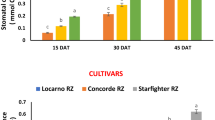Abstract
Species of Paulownia are fast-growing trees that are planted in many countries in green spaces and agroforestry systems. We studied the influence of irrigation on the diameter growth of 2-year-old Paulownia tomentosa saplings planted in 3 m × 3 m grids at Nazlou Campus of Urmia University, Iran. Completely randomized experimental design was used with four irrigation amount, viz. 10, 15, 20 and 25 L, and three irrigation intervals, viz. 3- and 6-days, in 8 replications. During the growth season, we measured collar diameters of all saplings at the end of each month. Diameter growth declined with reduced irrigation amount and increased irrigation interval. The lowest average diameter growth (9 mm) was recorded for 10 L water at 6-day intervals and maximum average diameter growth (28.7 mm) was recorded for 25 L volume at 3-day intervals. The latter treatment resulted in significantly greater diameter growth than any other treatment (except 20 L at 3-day intervals). More than 80 % of diameter growth was achieved in the first 3 months. Therefore, it is essential to irrigate with 25 L of water at 3-day intervals during the first three growth months to achieve maximum diameter growth for 2-year-old P. tomentosa saplings.


Similar content being viewed by others
References
Ashori A (2006) Non-wood fibers—a potential source of raw material in paper making. Polym Plast Technol Eng J 45(10):1133–1136
Ayan S, Sivacioglu A, Bilir N (2006) Growth variation of Paulownia Sieb. and Zucc. species and origins at the nursery stage in Kastamonu-Turkey. J Environ Biol 27(3):499–504
Azzarello E, Pandolfi C, Rossi M, Mugnai S, Mancuso S (2012) Ultramorphological and physiological modifications induced by high zinc levels in Paulownia tomentosa. Environ Exp Bot 81:11–17
Bargali K, Bargali SS (1997) Nutrient utilization efficiencies of two central Himalayan tree species. J Trop For Sci 12(3):450–458
Bargali K, Tewari A (2004) Growth and water relation parameters in drought-stressed Coriaria nepalensis seedlings. J Arid Environ 58:505–512
Bergmann BA (2003) Five years of Paulownia field trials in North Carolina. New For 25:185–199
Borough C (1991) Paulownia—wonder tree or this year’s wonder? Aust For Grow 14(3) (Special Lift out Section No. 18)
Carpenter SB, Smith ND (1979) Germination of paulownia seeds after stratification and dry storage. Tree Plant Notes 30(4):4–6
Clatterbuck WK, Hodges DG (2004) Paulownia, tree crops for marginal farmland with financial analysis. J For 87:19–24
Fitzgerald JM, Loeb RE (2008) Historical ecology of Inwood Hill Park, Manhattan, New York. J Torrey Bot Soc 135(2):281–293
Graves DH, Stringer JW (1989) Paulownia–A Guide to Establishment and Cultivation. University of Kentucky Cooperation Extension Service, Lexington, p 85
Jazireyi MH (2003) Silvics of Zagros. Tehran University Press, Tehran, p 560
Johnson J, Mitchem D, Kreh R (2003) Establishing royal paulownia on the Virginia Piedmont. New For 25:11–23
Kays J, Johnson D, Stringer JW (1998) How to produce and market Paulownia. University of Maryland Cooperation Extension Service, Maryland, p 22
Krikorian AD (1988) Paulownia in China: cultivation and utilization. Econ Bot 42(2):283
Llano-Sotelo JM, Alcaraz-Melendez L, Castellanos Villegas AE (2010) Gas exchange in Paulownia species growing under different soil moisture conditions in the field. J Environ Biol 31(4):497–502
Longbrake A, Christina W, Brian C (2001) Biomass allocation and resprouting ability of princess tree (Paulownia tomentosa: Scrophulariaceae) across a light gradient. Am Midl Nat 146(2):388–403
Mishra A, Swamy SL, Bargali SS, Singh AK (2010) Tree growth, biomass and productivity of wheat under five promising clones of Populus deltoids. Int J Ecol Environ Sci 36(2/3):167–174
Riahifar N, Fallah A, Mohammadi Samani K, Gorji Mahlebani Y (2009) Comparing the growth of Paulownia fortunei and Populus deltoides plantations under different spacing in northern Iran. Iran J For Poplar Res 16(3):444–454
Seeley S (1990) Hormonal transduction of environmental stresses. HortScience 25:1369–1376
Swamy SL, Mishra A, Puri S (2006) Comparison of growth, biomass and nutrient distribution in five promising clones of Populus deltoides under an agrisilviculture system. Bioresour Technol 97:57–68
Yadav NK, Vaidya BN, Henderson K, Lee JF, Stewart WM, Dhekney SA, Joshee N (2013) A review of Paulownia biotechnology: a short rotation, fast growing multipurpose bioenergy tree. Am J Plant Sci 4:2070–2082
Yin R, He Q (1997) The spatial and temporal effects of paulownia intercropping-the case of northern China. Agrofor Syst 37:91–109
Author information
Authors and Affiliations
Corresponding author
Additional information
The online version is available at http://www.springerlink.com
Corresponding editor: Yu Lei
Rights and permissions
About this article
Cite this article
Rad, J.E., Mirkala, S.R.M. Irrigation effects on diameter growth of 2-year-old Paulownia tomentosa saplings. J. For. Res. 26, 153–157 (2015). https://doi.org/10.1007/s11676-014-0007-7
Received:
Accepted:
Published:
Issue Date:
DOI: https://doi.org/10.1007/s11676-014-0007-7




